Book contents
- Frontmatter
- Contents
- Notes on contributors
- Foreword: science, participation, and sustainability
- Foreword: sustainability, energy use, and public participation
- Preface
- Acknowledgments
- Part I Concepts and insights
- Part II Experiences with IA Focus Groups
- Part III Further forms of participation
- Introduction
- 7 Venture capital and climate policy
- 8 COOL: Exploring options for carbon dioxide-reduction in a participatory mode
- 9 Expert stakeholder participation in the Thames region
- 10 On the art of scenario development
- Part IV Future perspectives
- References
- Index
7 - Venture capital and climate policy
Published online by Cambridge University Press: 22 September 2009
- Frontmatter
- Contents
- Notes on contributors
- Foreword: science, participation, and sustainability
- Foreword: sustainability, energy use, and public participation
- Preface
- Acknowledgments
- Part I Concepts and insights
- Part II Experiences with IA Focus Groups
- Part III Further forms of participation
- Introduction
- 7 Venture capital and climate policy
- 8 COOL: Exploring options for carbon dioxide-reduction in a participatory mode
- 9 Expert stakeholder participation in the Thames region
- 10 On the art of scenario development
- Part IV Future perspectives
- References
- Index
Summary
Introduction: why venture capital?
In the long run, a sustainability transition will require major shifts in our socio-economic activities. As an example, consider the challenge that climate change issues pose for Europe. An effective European climate policy ultimately needs to achieve drastic reductions in greenhouse gas emissions. In order to keep the risk of major disruptions of human and natural systems moderate, global emissions would need to be below current levels in the long term (see Wigley, Richels, and Edmonds 1996). But population and per capita emissions in developing countries will continue to rise significantly for some time to come. The EU and other developed regions have a special responsibility to lead the way in reducing global emissions, not only because of their economic ability to initiate change, but also because their per capita emissions and cumulative historical emissions far exceed those of developing countries.
The IA Focus Group research discussed in the preceding chapters has shown that many citizens across Europe see scenarios of significantly lower energy use and greenhouse gas emissions as desirable (see also Kasemir et al. 2000). But how could such a future be realized? The feasibility of such scenarios depends on interacting patterns of lifestyle changes and technological changes. One option to induce technological change toward low-carbon products and processes is to make them more competitive by putting a tax burden on carbon emissions. This would not necessarily lead to welfare losses.
- Type
- Chapter
- Information
- Public Participation in Sustainability ScienceA Handbook, pp. 155 - 175Publisher: Cambridge University PressPrint publication year: 2003
- 2
- Cited by

